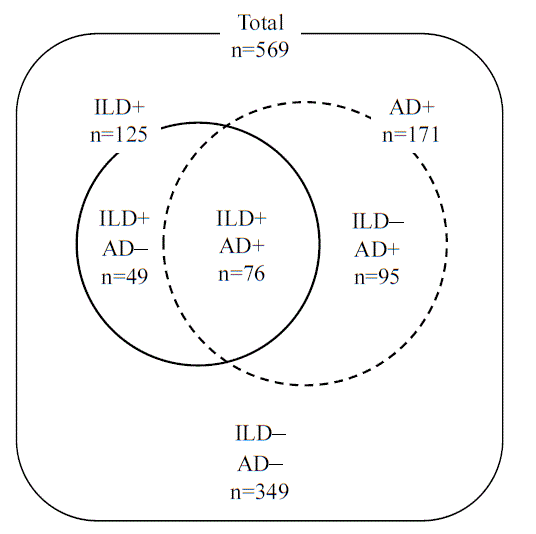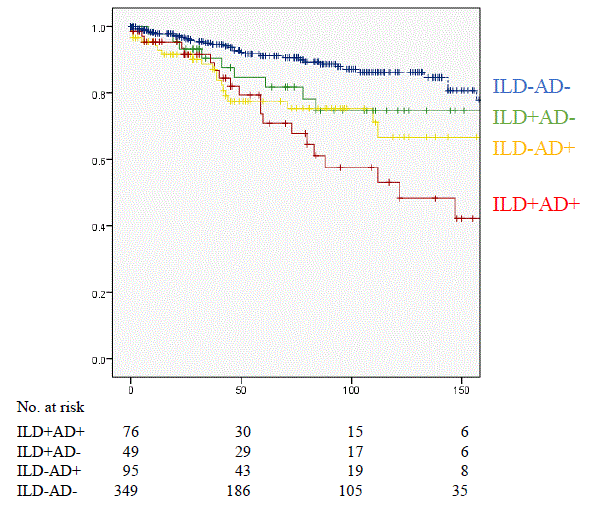Session Information
Date: Tuesday, November 14, 2023
Title: (2095–2140) RA – Diagnosis, Manifestations, and Outcomes Poster III
Session Type: Poster Session C
Session Time: 9:00AM-11:00AM
Background/Purpose: How interstitial lung disease (ILD) and airway disease (AD) independently affect the clinical course of rheumatoid arthritis (RA) is unclear since previous studies conflated ILD and AD. We aimed to clarify the effects of ILD, AD, and their combination on RA disease activity and infections.
Methods: RA patients at our facilities during 2011 and 2021 that had chest computed tomography (CT) scans were investigated retrospectively. Baseline was defined as ‘time of first CT scan’, and final observation as ‘last visit’. Two experienced radiologists evaluated CT findings. We excluded patients with incomplete evaluation of ILD/AD in CT scans. The study primary outcome was development of infection requiring hospitalization, while the secondary was RA disease activity at final observation. We compared patients with and without ILD, and with and without AD. To identify factors associated with RA disease activity or infections, multivariate analyses were performed.
Results: We enrolled 569 patients (75.7% female, mean: age 60.9 yrs, observation period 73.9 mo.), including 125 (22.0%) with ILD, 171 (30.1%) AD, and 76 (13.4%) both (Figure 1).
At baseline, ILD+ and AD+ patients were older significantly than ILD– and AD– patients. ILD+ patients received significantly less methotrexate (MTX) than ILD– patients, while treatments for AD+ and AD– patients were comparable. RA disease activity was similar among groups.
At final observation, ILD+ and AD+ patients had significantly higher Disease Activity Score 28 based on C-reactive protein (DAS28-CRP) (mean 2.4 vs. 2.1 and 2.3 vs. 2.1) and Simplified Disease Activity Index (SDAI) (mean 7.6 vs. 5.8 and 7.4 vs. 5.6) than ILD– and AD– patients. ILD+ patients received significantly less MTX but more glucocorticoids than ILD– patients. ILD+AD+ patients had higher RA activity than the other groups.
Analysis of covariance revealed significant association between DAS28-CRP and ILD [F(1,155) = 7.248], but not AD or their interaction. Similar results were found for SDAI. Kaplan-Meier analysis with log-rank tests revealed significantly lower infection-free rate in ILD+ and AD+ than ILD– and AD– patients. In ILD+ patients, the rate decreased prominently after 50 months. The infection-free rate was lower in ILD+AD+ patients than the other groups (Figure 2).
Cox regression analysis revealed significant association between infections and AD (hazard ratio [HR] 1.970, 95% confidence interval [CI] 1.065-3.646), but not ILD or their interaction. Cox regression analysis with time-dependent covariates, categorizing ILD into >50 and ≤50 months, showed significant association between infections and ILD >50 months (HR 3.702, 95% CI 1.637-8.372) and AD (HR 1.744, 95% CI 1.054-2.885), but not ILD ≤50 months.
Conclusion: Disease activity of RA was independently associated with ILD but not AD, suggesting an impact of reduced MTX in ILD. Risks of developing infections included ILD after 50 months and AD, both independently. The ILD+AD+ group showed higher RA activity and a greater susceptibility to infection than the other groups. Careful detection of ILD and AD, along with implementation of safe and effective alternative treatments, is necessary.
To cite this abstract in AMA style:
Yoshida M, Zoshima t, Mizushima I, Kawano M. Independent and Combined Impact of Interstitial Lung Disease and Airway Disease on Rheumatoid Arthritis Disease Activity and Infections [abstract]. Arthritis Rheumatol. 2023; 75 (suppl 9). https://acrabstracts.org/abstract/independent-and-combined-impact-of-interstitial-lung-disease-and-airway-disease-on-rheumatoid-arthritis-disease-activity-and-infections/. Accessed .« Back to ACR Convergence 2023
ACR Meeting Abstracts - https://acrabstracts.org/abstract/independent-and-combined-impact-of-interstitial-lung-disease-and-airway-disease-on-rheumatoid-arthritis-disease-activity-and-infections/


